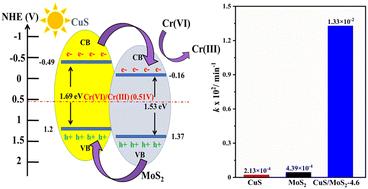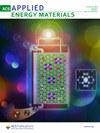构建可见光活性 CuS/MoS2 异质结,提高六价铬的光氧化还原能力
IF 5.4
3区 材料科学
Q2 CHEMISTRY, PHYSICAL
引用次数: 0
摘要
研究人员采用简便的一步水热法制备了 CuS/MoS2 异质结,并通过在可见光照射下对 Cr(VI) 的光诱导进行了评估。CuS/MoS2 异质结呈现出分层多孔结构,由相交的薄纳米片自组装而成,形成花朵状形态。优化后的 CuS/MoS2 异质结(CuS/MoS2-4.6)在可见光下对六价铬的去除表现出卓越的光催化性能,其 k 值为 1.33 × 10-2 min-1,远高于纯 CuS(2.13 × 10-4 min-1)和 MoS2(4.39 × 10-4 min-1)。Cr(VI)光还原性能的增强归因于构建了 II 型 CuS/MoS2 异质结,其中 CuS 的导带(CB)中的电子由于有利的带排列而转移到 MoS2 的 CB 中,而 MoS2 价带(VB)中的空穴则流向 CuS 的 VB。这导致了电子和空穴的有效空间分离和转移,抑制了光生载流子的重组,从而提高了显著的光催化活性。这项研究成果为六价铬的光氧化还原提供了一种前景广阔的异质结催化剂。本文章由计算机程序翻译,如有差异,请以英文原文为准。


Construction of visible light active CuS/MoS2 heterojunctions for heightened photoreduction of Cr(vi)
CuS/MoS2 heterojunctions were fabricated by a facile one-step hydrothermal method and evaluated via the photoreduction of Cr(vi) under visible light irradiation. The CuS/MoS2 heterojunctions demonstrated a hierarchical porous structure, self-assembled from intersecting thin nanosheets, which resulted in a flower-like morphology. The optimized CuS/MoS2 heterojunction (CuS/MoS2-4.6) exhibited superior photocatalytic performance toward the removal of Cr(vi) under visible light with a k value of 1.33 × 10−2 min−1, which was much higher than that of pure CuS (2.13 × 10−4 min−1) and MoS2 (4.39 × 10−4 min−1). The enhanced Cr(vi) photoreduction performance was ascribed to the construction of a type II CuS/MoS2 heterojunction, in which electrons in the conduction band (CB) of CuS were transferred to the CB of MoS2 due to the favorable band alignment, while holes in the valence band (VB) of MoS2 flowed to the VB of CuS. This led to the efficient spatial separation and transfer of electrons and holes, inhibiting the recombination of photogenerated carriers, thus boosting the remarkable photocatalytic activity. This work provides a prospective heterojunction catalyst for photoreduction of Cr(vi).
求助全文
通过发布文献求助,成功后即可免费获取论文全文。
去求助
来源期刊

ACS Applied Energy Materials
Materials Science-Materials Chemistry
CiteScore
10.30
自引率
6.20%
发文量
1368
期刊介绍:
ACS Applied Energy Materials is an interdisciplinary journal publishing original research covering all aspects of materials, engineering, chemistry, physics and biology relevant to energy conversion and storage. The journal is devoted to reports of new and original experimental and theoretical research of an applied nature that integrate knowledge in the areas of materials, engineering, physics, bioscience, and chemistry into important energy applications.
 求助内容:
求助内容: 应助结果提醒方式:
应助结果提醒方式:


